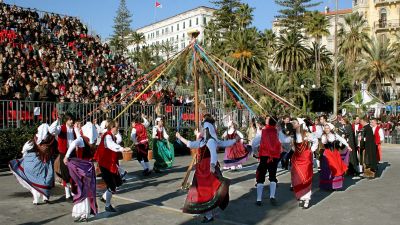In Italy, dance is a very important traditional and cultural expression. Not only does it unite people in its representation, but it brings out the strong symbolistic representations that express the bond of being part of the territory. Each region or land has a type of dance tied to its local traditions.
La Danza del Laccio o il Ballo del Palo intrecciato is a typical dance that we can see at Penne Sant'Andrea, a place in the province of Teramo, between the Adriatic coast and the mountains of Gran Sasso National Park and Lake Mountain. This dance has a prehistoric origin, a rich symbol from start to end. It not only represents the link between earth and man but the various stages of life. From the engagement to the marital bond, a symbol of good wishes and fertile prosperity to the couple in joining. The 10 couples that enter the square, where a pole in the center has 20 silks ascending from the top, are dressed in traditional light blue clothing. Entering, they pass under an arc of girls that have silk laces in their hands and dance to the sound of tambourines, a typical musical instrument in the area. The couples, after they have entered together, separate, and each dancer takes one of the 20 silk love laces. At the sound of du’ botte, a typical musical instrument similar to the accordion but smaller and probably named because it is played with two hands, the couples start to dance moving from left to right in pairs.
The symbols continue with a dance movement that involves the various couples holding their gaze on one another. The men watch the women intensely and in a passionate fashion, while the women oppose these looks with reluctance and encourage the man to persevere with his gaze.
The music starts to change and speed up and the couples change their pace and rotate together at the poles, beginning to become closer, weaving the ribbons and laces together to represent the bond of marriage that earth unites for all of their life, continuing to dance faster. The dance concludes with a frantic force that involves everyone in the square.
In Penne Sant’Andrea there is a Folklore group that preserves this dance and keeps this dance rooted in the territory, not wanting to lose this beautiful tradition.
I balli tradizionali italiani
In Italia la danza è un’espressione tradizionale e culturale molto importante. Essa non solo unisce le persone nella sua rappresentazione ma fa emergere con le sue raffigurazioni le espressioni simboliche forti che esprimono il legame di appartenenza con il territorio. Ogni regione o paese ha un ballo tipico legato alla tradizione locale.
La danza del laccio o il ballo del palo intrecciato è un ballo tipico che possiamo vedere a Penne Sant’ Adrea, una località della provincia di Teramo, che si trova tra la costa dell’Adriatico e le cime montuose del Parco Nazionale del Gran Sasso e Monti della Laga.
Questo ballo affonda le sue origini nella preistoria, si pensa fosse usato come pratica arborea in relazione al culto degli alberi basato sull’evocazione della forza vitale e della fecondità. Il ballo è ricco di simboli dall’inizio alla fine. Esso rappresenta non solo il legame dell’uomo con la propria terra, ma anche le varie tappe della vita; dal fidanzamento fino al legame matrimoniale, è simbolo di buon augurio e di prospera fecondità alla coppia che si unisce. Le dieci coppie che entrano all’interno della piazza, dove viene issato un palo al centro con venti nastri di seta che scendono dall’alto, sono vestite con abiti tradizionali abruzzesi e nell’entrare, passano sotto a un arco di ragazze che hanno lacci di seta in mano e danzano al suono di tamburelli, strumenti musicali tipici della zona.
Le coppie, dopo essere entrate insieme, si separano e ogni danzatore prende un laccio dei 20 lacci d’amore, che rappresentano il legame dell’uomo con la terra, che sono stati affissi nel punto più alto del palo. Al suono del “du’ botte”, uno strumento musicale tipico abruzzese simile alla fisarmonica ma più’ piccolo, si chiama “du’ botte “proprio perché viene suonato con due botte di mano, le coppie iniziano a danzare girando intorno al palo mantenendo in mano ognuna un filo di seta e facendo un movimento da sinistra verso destra a coppie sciole.
I simboli continuano con il momento della danza che coinvolge le varie coppie che sostengono i propri sguardi a vicenda. L’uomo guarda la donna intensamente e in modo passionale, mentre la donna si contrappone a questi sguardi con riluttanza e incita l’uomo a perseverare negli sguardi.
La musica inizia ad aumentare sia nel suono che nella velocità e le coppie aumentano la velocità e ruotando intorno al palo iniziano ad avvicinarsi sempre di più intrecciando i nastri che hanno in mano tra loro a rappresentare il legame del matrimonio che li terrà uniti per tutta la loro vita, mentre continuano a danzare sempre più velocemente. La danza si conclude con un frenetico vortice che coinvolge tutti i presenti nella piazza.
A Penne Sant’Andrea esiste un gruppo Folkloristico, che preserva questo ballo e mantiene questo ballo radicato nel territorio, non si vuole infatti perdere questa bellissima tradizione.
{/mprestriction}



